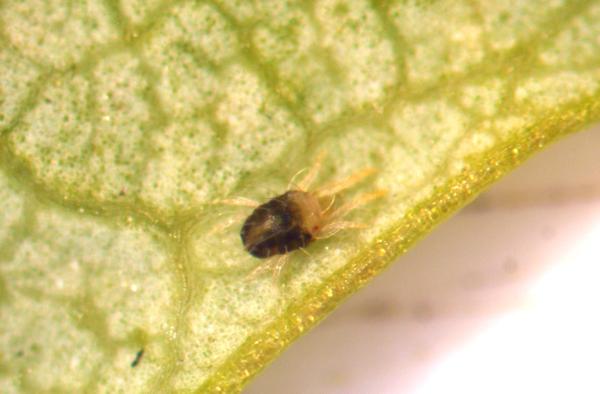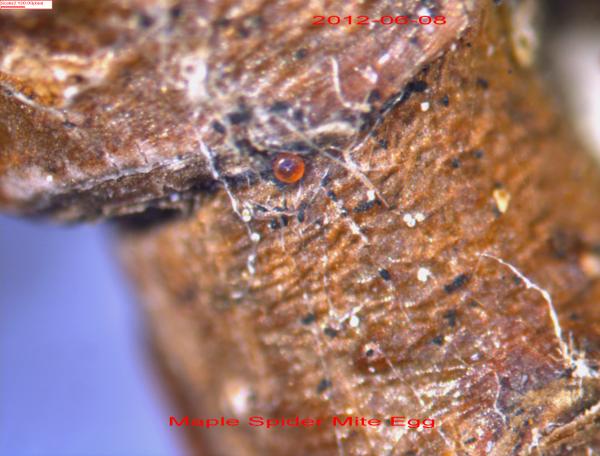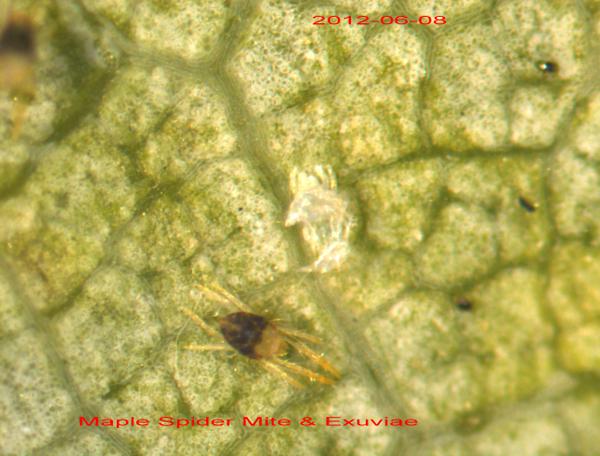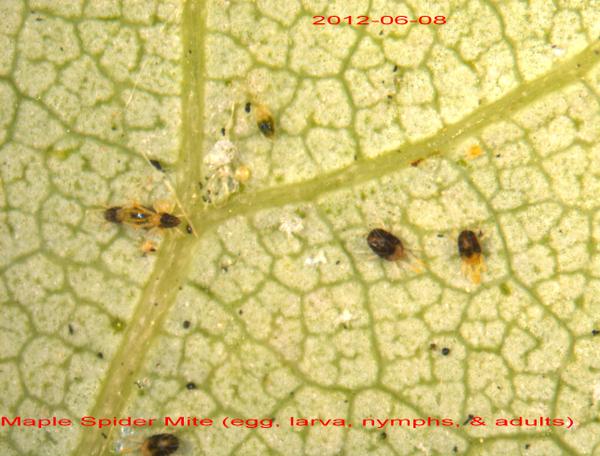Identification and Damage
Maple spider mites are frequent and damaging pests of nursery and landscape maple trees (Acer spp.), most commonly Acer rubrum and Acer x freemanii. Adults range from 0.25 to 1 mm in length, have multiple hairs along their back, and are reddish-brown in color. Due to their small size, they require a hand lens or stereomicroscope to see and identify. Eggs are spherical, red to clear in color and commonly found in bark crevices and near branch buds during the winter or along leaf veins during spring, summer, and fall. Larvae have six legs, while all later developmental stages have eight legs. Larvae and nymphs may have lighter colorations or a green hue.
Spider mites have needle-like mouthparts that rupture plant cells. Once cells are ruptured, the spider mite will probe deeper with its mouthparts, feeding on cell sap and causing fine flecking or brown stippling of the foliage. This can cause portions of or entire leaves to become yellow, silver, or bronzed, reducing aesthetic value and the leaf’s photosynthetic capacity. Years of repeated damage can reduce plant growth and vigor. Mite damage becomes increasingly apparent in hot weather as damaged tissue dies. By stippling leaves mites reduce fall color intensity.
Biology
These mites overwinter in bark crevices on the trunk and branches of maple trees as adults and eggs. Observations suggest that mites also seek refuge under tests of dead armored scale insects as protection during dormancy. Following leaf development in the spring, they migrate to the underside of the leaves where they will remain until fall. Here, maple spider mites will feed on chlorophyll-containing non-vascular leaf cells. These spider mites undergo five developmental stages: egg, larva, protonymph, deutonymph, and adult. As they transition through life stages, they will leave behind their exoskeletons on the leaf surface, creating white debris. It takes approximately 2-3 weeks to complete one generation. Therefore, many generations occur during a single season, facilitating rapid buildup of large, damaging populations.
Scouting and Monitoring
Scout for spider mites in spring by inspecting the undersides of leaves or by thrashing leaves against a white clipboard or paper plate. To the naked eye, spider mites appear as small, slowly moving, brown or black dots. Fast moving dots are usually predatory mites. Focus scouting on particularly susceptible cultivars such as October Glory or Autumn Blaze or trees that were most damaged the previous year. Trees that were infested the previous year will have overwintering mites and eggs and are likely to be infested again.
Decision Making
There are no aesthetic or economic thresholds for maple spider mites in nurseries or landscapes. Consider planting site and history in landscapes. If trees are planted in a stressful, hot habitat like a parking lot, a few mites discovered while scouting are more likely to become a damaging population. In complex habitats with lots of predators they are unlikely to be a problem. In nurseries outbreaks are more likely and tolerance for damage is less.
Intervention
Cultural control:
Reducing plant stress by proper planting and watering may reduce susceptibility to infestation by maple spider mites. However, excessive nitrogen fertilization will increase spider mite abundance by making the tree more nutritious to pests and reducing the tree’s natural defenses. Selecting maple cultivars less susceptible to maple spider mites can also be an effective approach to preventing damage. Freeman maples are more prone to maple spider mite infestation and damage than red maple cultivars.
Red maple cultivars have different levels of susceptibility to damage by maple spider mites. This is due to differences in resistance or quality of the leaves that reduce population growth on some cultivars. It is also due to differences in the abundance of leaf structures called domatia among cultivars. Domatia are patches of dense hairs or pockets at leaf vein junctions that provide refuge for predator mites. Evidence suggests that cultivars without domatia have fewer predators and more spider mites and damage. Dust and debris on foliage can also increase mite abundance by creating habitat refugia.
Biological control:
Maple spider mites have no known insect parasites, but predators usually provide adequate control of maple spider mites in landscapes. Predators include: lady beetles, predatory thrips, predatory mites, lacewing larvae, and minute pirate (Anthocorid) bugs. The predatory mites Neoseiulus fallacis, Typhlodromus caudligans, and Zetzellia mali are common predators of the maple spider mites. Maple spider mites are often more abundant and damaging in nurseries because plants are grown in monoculture, in full sun, and natural enemies are less abundant. Pesticides also tend to increase spider mite abundance. For example, early-season use of pyrethroids leads to late season outbreaks of maple spider mites in nurseries by killing natural enemies. Imidacloprid applications can also result in spider mite outbreaks. Some predatory mites can be purchased from commercial insectaries to release in landscapes or nurseries but their efficacy for maple spider mites in these systems is unknown.
Chemical control:
Pyrethroids and other broad-spectrum pesticides targeting other arthropod pests may initiate maple spider mite outbreaks on maple trees. Spider mites are physiologically different than insects; therefore, pesticide chemistry must specifically target mites and have a miticide designation on the label. Horticultural oils and dormant oils can also effectively control spider mite populations but thorough coverage is essential.
Publication date: July 3, 2015
N.C. Cooperative Extension prohibits discrimination and harassment regardless of age, color, disability, family and marital status, gender identity, national origin, political beliefs, race, religion, sex (including pregnancy), sexual orientation and veteran status.






